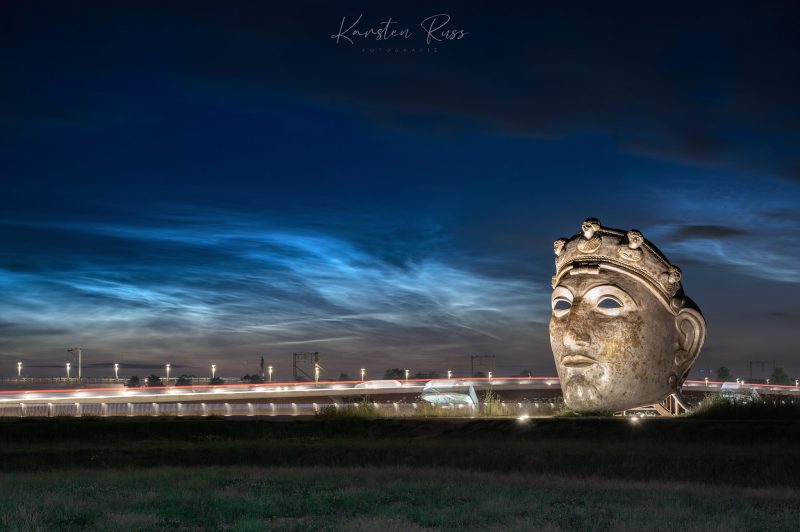
Noctilucent clouds shine at night
The season for noctilucent clouds at northerly latitudes has begun for 2021! Every year – from about May through August in the Northern Hemisphere, and from November through February in the Southern Hemisphere – people at high latitudes report seeing noctilucent or night-shining clouds. They are, very simply, clouds that shine at night. And they are beautiful.
In recent years, northern summertime noctilucent clouds have set records for low-latitude sightings. In 2019, for example, people observed them as far south as Los Angeles and Las Vegas. Usually, though, they’re seen from higher latitudes. 2021 might be a good year for noctilucent clouds, according to Spaceweather.com, which said as early as May 28, 2021 that:
The reason may be extra water in the mesosphere [about 30 to 50 miles, or 50 to 85 km, above Earth’s surface]. NASA satellite data show that 2021 is one of the wettest years since 2007.
Over the past week (around mid-June 2021), there’ve been many sightings of noctilucent clouds from latitudes like those in the northern U.S., Canada the U.K. and Europe (including France and the Netherlands), as reported by Spaceweather.com and on the excellent Facebook page Noctilucent Clouds Around the World.
Right about now – mid-June to July – is typically when noctilucent clouds are most widespread.
Are you a northern skywatcher looking for noctiluent clouds? If so, here’s a quick tip from Spaceweather.com: Look west about 30 minutes after sunset. If you see luminous blue-white tendrils spreading across the sky, you might have spotted a noctilucent cloud.
Want to see noctilucent clouds, as the photographers on this page did? Keep reading for tips.
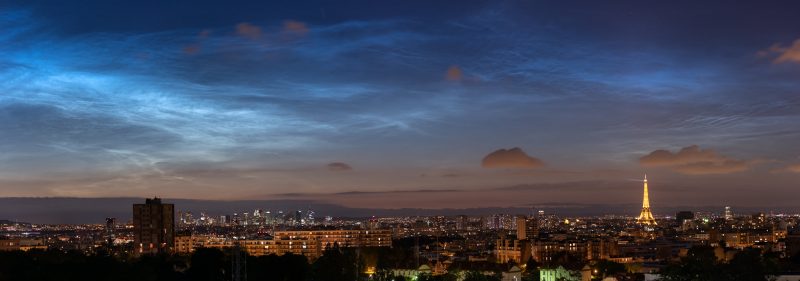
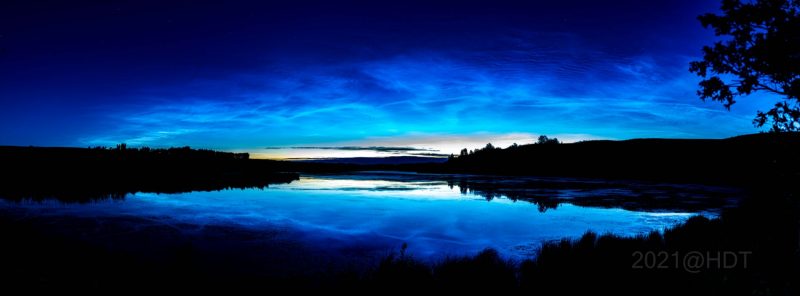
Some noctilucent clouds last night, June 14, low in the north above a receding thunderstorm, over the Alberta prairies. So clouds in the troposphere and mesosphere, the latter much higher and farther away than the former. Tis the season for NLCs. pic.twitter.com/8W9bdVtvMf
— Alan Dyer (@amazingskyguy) June 16, 2021
How to see noctilucent clouds
If you want to see the clouds, what steps should you take? Remember, you have to be at a relatively high latitude on Earth to see them: typically between about 45 degrees and 60 degrees north or south latitude, although the clouds can sometimes be seen at lower latitudes, particularly following the solstices.
For best results, look for these clouds from about May through August in the Northern Hemisphere, and from November through February in the Southern Hemisphere.
Noctilucent clouds are primarily visible when the sun is just below the horizon, say, from about 90 minutes to about two hours after sunset or before sunrise. At such times, when the sun is below the ground horizon but visible from the high altitude of noctilucent clouds, sunlight illuminates these clouds, causing them to glow in the dark night sky.
So … how can you see them? They’re not always present. You’ve got to look when a good display is taking place. Your best bet is to hook up with a web page that tracks them. Try Spaceweather.com. Or try the Facebook page Noctilucent Clouds Around the World, where anyone can participate, ask questions, learn, and share photos.
If you take photos of your own, please also share them with us at EarthSky Community Photos. ]
Share your noctilucent cloud photos with EarthSky
What are noctilucent clouds?
Noctilucent clouds form in the highest reaches of the atmosphere – the mesosphere – as much as 50 miles (80 km) above the Earth’s surface. They’re thought to be made of ice crystals that form on fine dust particles from meteors. They can only form when temperatures are incredibly low and when there’s water available to form ice crystals.
Why do these clouds – which require such cold temperatures – form in the summer? It’s because of the dynamics of the atmosphere. You actually get the coldest temperatures of the year near the poles in summer at that height in the mesosphere.
Here’s how it works: during summer, air close to the ground gets heated and rises. Since atmospheric pressure decreases with altitude, the rising air expands. When the air expands, it also cools down. This, along with other processes in the upper atmosphere, drives the air even higher causing it to cool even more. As a result, temperatures in the mesosphere can plunge to as low as -210 degrees Fahrenheit (-134 degrees Celsius).
In the Northern Hemisphere, the mesosphere often reaches these temperatures by mid-May, in most years.

Since the clouds are so sensitive to the atmospheric temperatures, they can act as a proxy for information about the wind circulation that causes these temperatures. First of all, they can tell scientists that the circulation exists, and also tell us something about the strength of the circulation.
Scientists studying these clouds have included those from NASA’s Aeronomy of Ice in the Mesosphere (AIM) satellite. This satellite, launched in 2007, has observed noctilucent clouds using several onboard instruments to collect information such as temperature, atmospheric gases, ice crystal size and changes in the clouds, as well as the amount of meteoric space dust that enters the atmosphere. You can find out what they are learning at NASA’s AIM page.
Noctilucent clouds are like regular clouds in that they move in the sky. See the subtle movement of noctilucent clouds in the video below:
And here are a few more recent photos. If you capture a photo of noctilucent clouds, please submit it to EarthSky here.


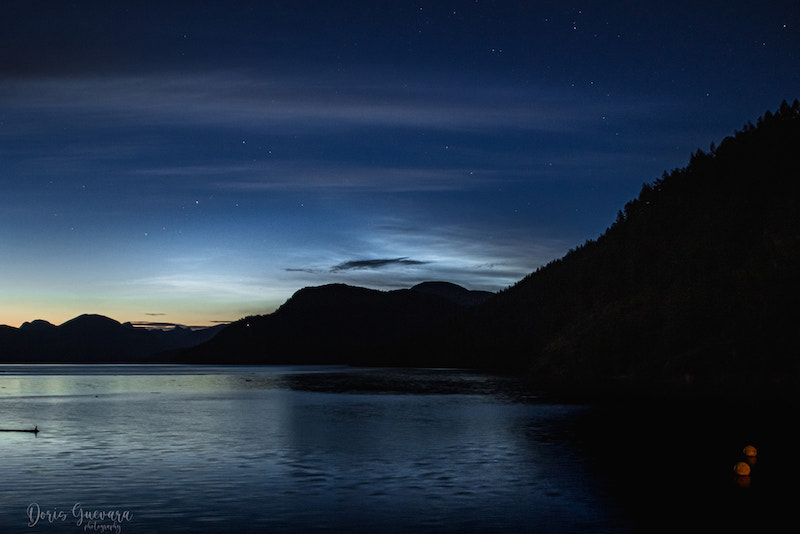
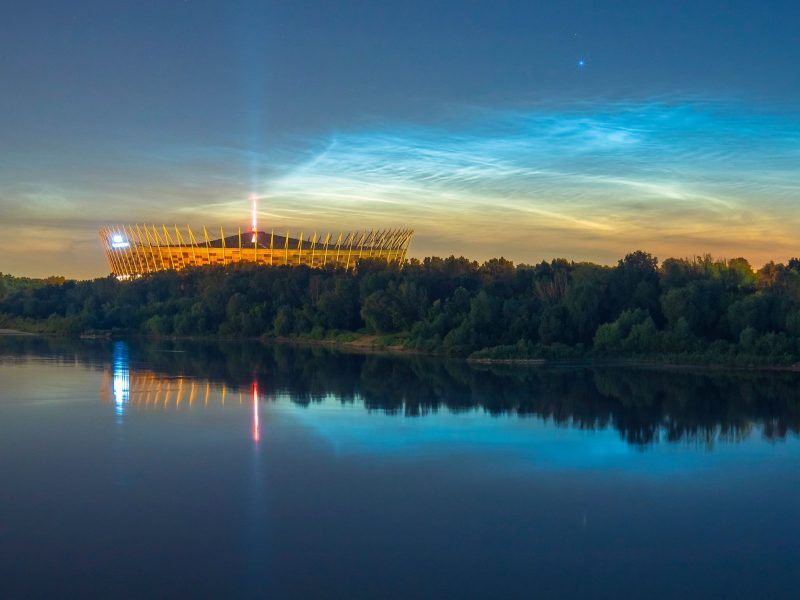
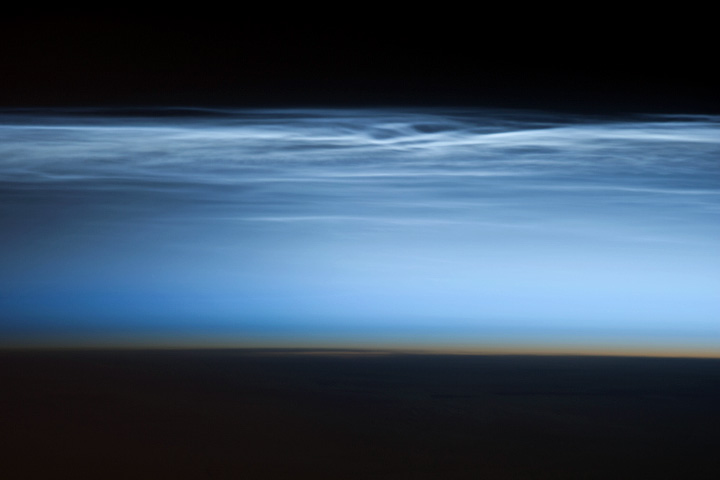
Bottom line: You can see noctilucent clouds (aka night-shining clouds or NLCs) during summer at high-latitude. They form in the highest reaches of the atmosphere – the mesosphere – as much as 50 miles (80 km) above the surface.
Visit SpaceWeather’s RealTime Noctilucent Cloud Gallery
Visit the Facebook page Noctilucent Clouds Around the World
The post The secrets of noctilucent clouds first appeared on EarthSky.
from EarthSky https://ift.tt/3xFC9tT

Noctilucent clouds shine at night
The season for noctilucent clouds at northerly latitudes has begun for 2021! Every year – from about May through August in the Northern Hemisphere, and from November through February in the Southern Hemisphere – people at high latitudes report seeing noctilucent or night-shining clouds. They are, very simply, clouds that shine at night. And they are beautiful.
In recent years, northern summertime noctilucent clouds have set records for low-latitude sightings. In 2019, for example, people observed them as far south as Los Angeles and Las Vegas. Usually, though, they’re seen from higher latitudes. 2021 might be a good year for noctilucent clouds, according to Spaceweather.com, which said as early as May 28, 2021 that:
The reason may be extra water in the mesosphere [about 30 to 50 miles, or 50 to 85 km, above Earth’s surface]. NASA satellite data show that 2021 is one of the wettest years since 2007.
Over the past week (around mid-June 2021), there’ve been many sightings of noctilucent clouds from latitudes like those in the northern U.S., Canada the U.K. and Europe (including France and the Netherlands), as reported by Spaceweather.com and on the excellent Facebook page Noctilucent Clouds Around the World.
Right about now – mid-June to July – is typically when noctilucent clouds are most widespread.
Are you a northern skywatcher looking for noctiluent clouds? If so, here’s a quick tip from Spaceweather.com: Look west about 30 minutes after sunset. If you see luminous blue-white tendrils spreading across the sky, you might have spotted a noctilucent cloud.
Want to see noctilucent clouds, as the photographers on this page did? Keep reading for tips.


Some noctilucent clouds last night, June 14, low in the north above a receding thunderstorm, over the Alberta prairies. So clouds in the troposphere and mesosphere, the latter much higher and farther away than the former. Tis the season for NLCs. pic.twitter.com/8W9bdVtvMf
— Alan Dyer (@amazingskyguy) June 16, 2021
How to see noctilucent clouds
If you want to see the clouds, what steps should you take? Remember, you have to be at a relatively high latitude on Earth to see them: typically between about 45 degrees and 60 degrees north or south latitude, although the clouds can sometimes be seen at lower latitudes, particularly following the solstices.
For best results, look for these clouds from about May through August in the Northern Hemisphere, and from November through February in the Southern Hemisphere.
Noctilucent clouds are primarily visible when the sun is just below the horizon, say, from about 90 minutes to about two hours after sunset or before sunrise. At such times, when the sun is below the ground horizon but visible from the high altitude of noctilucent clouds, sunlight illuminates these clouds, causing them to glow in the dark night sky.
So … how can you see them? They’re not always present. You’ve got to look when a good display is taking place. Your best bet is to hook up with a web page that tracks them. Try Spaceweather.com. Or try the Facebook page Noctilucent Clouds Around the World, where anyone can participate, ask questions, learn, and share photos.
If you take photos of your own, please also share them with us at EarthSky Community Photos. ]
Share your noctilucent cloud photos with EarthSky
What are noctilucent clouds?
Noctilucent clouds form in the highest reaches of the atmosphere – the mesosphere – as much as 50 miles (80 km) above the Earth’s surface. They’re thought to be made of ice crystals that form on fine dust particles from meteors. They can only form when temperatures are incredibly low and when there’s water available to form ice crystals.
Why do these clouds – which require such cold temperatures – form in the summer? It’s because of the dynamics of the atmosphere. You actually get the coldest temperatures of the year near the poles in summer at that height in the mesosphere.
Here’s how it works: during summer, air close to the ground gets heated and rises. Since atmospheric pressure decreases with altitude, the rising air expands. When the air expands, it also cools down. This, along with other processes in the upper atmosphere, drives the air even higher causing it to cool even more. As a result, temperatures in the mesosphere can plunge to as low as -210 degrees Fahrenheit (-134 degrees Celsius).
In the Northern Hemisphere, the mesosphere often reaches these temperatures by mid-May, in most years.

Since the clouds are so sensitive to the atmospheric temperatures, they can act as a proxy for information about the wind circulation that causes these temperatures. First of all, they can tell scientists that the circulation exists, and also tell us something about the strength of the circulation.
Scientists studying these clouds have included those from NASA’s Aeronomy of Ice in the Mesosphere (AIM) satellite. This satellite, launched in 2007, has observed noctilucent clouds using several onboard instruments to collect information such as temperature, atmospheric gases, ice crystal size and changes in the clouds, as well as the amount of meteoric space dust that enters the atmosphere. You can find out what they are learning at NASA’s AIM page.
Noctilucent clouds are like regular clouds in that they move in the sky. See the subtle movement of noctilucent clouds in the video below:
And here are a few more recent photos. If you capture a photo of noctilucent clouds, please submit it to EarthSky here.





Bottom line: You can see noctilucent clouds (aka night-shining clouds or NLCs) during summer at high-latitude. They form in the highest reaches of the atmosphere – the mesosphere – as much as 50 miles (80 km) above the surface.
Visit SpaceWeather’s RealTime Noctilucent Cloud Gallery
Visit the Facebook page Noctilucent Clouds Around the World
The post The secrets of noctilucent clouds first appeared on EarthSky.
from EarthSky https://ift.tt/3xFC9tT

Aucun commentaire:
Enregistrer un commentaire